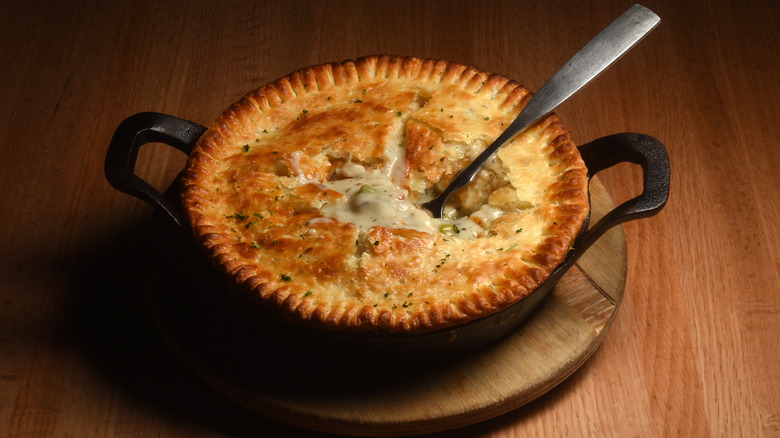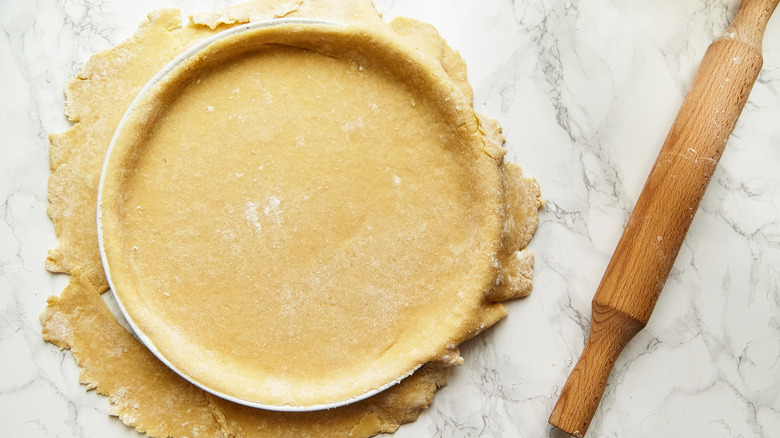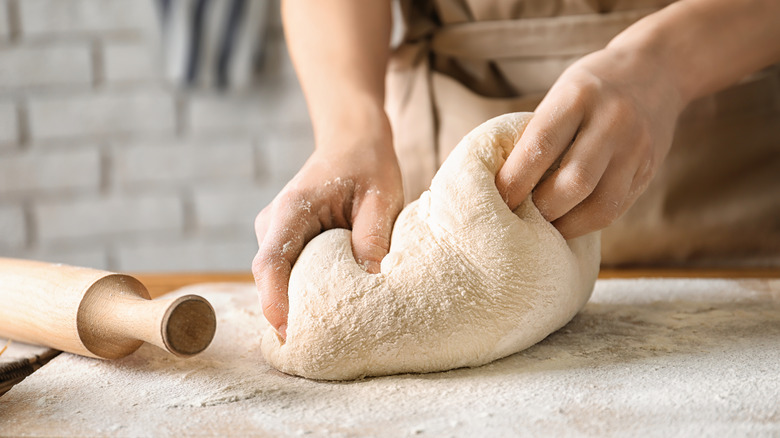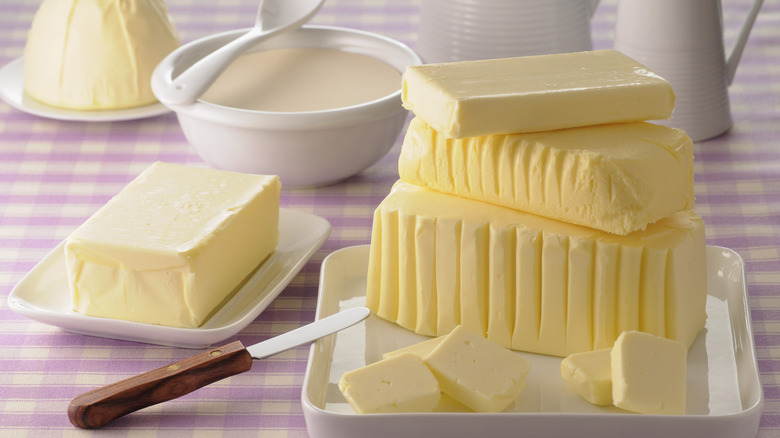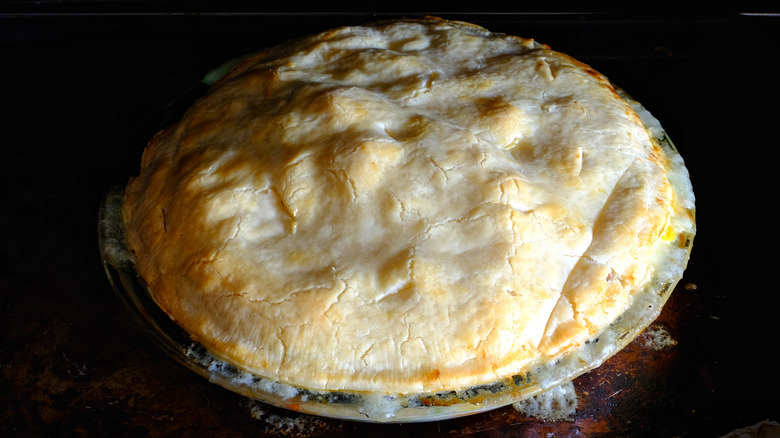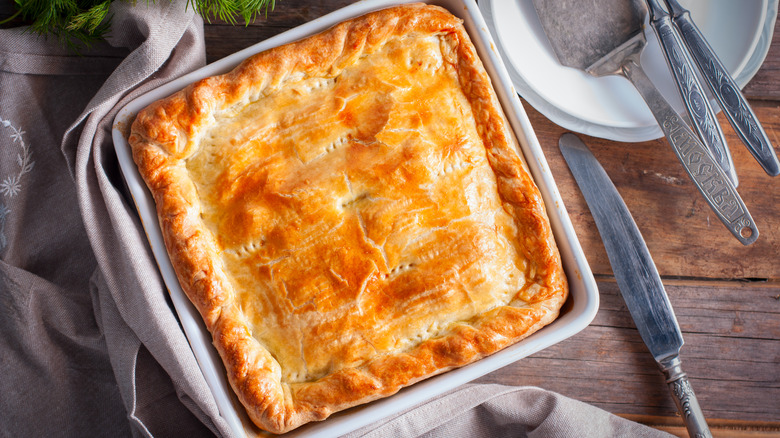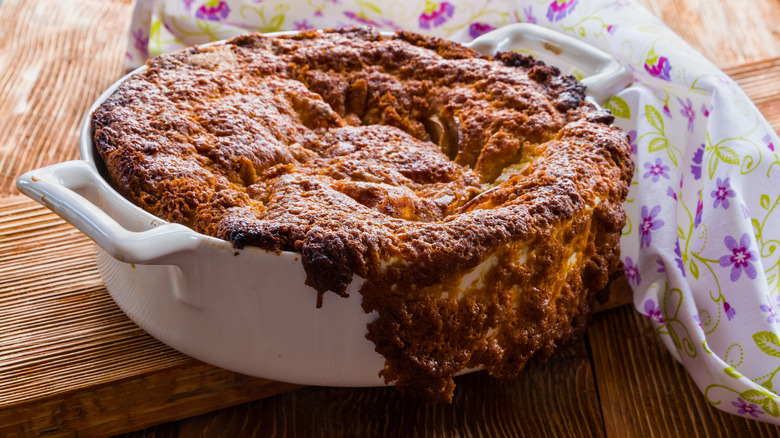13 Common Mistakes People Make With Chicken Pot Pie
Satisfying, comforting, and hearty, chicken pot pie is one of those foods that should never let you down. Every element of this dish is delicious, from the crisp crust to the velvety sauce to the savory chicken and vegetable center. The magical combination of these ingredients is nothing short of culinary alchemy. However, if not everything goes right, you could be left with a tragic disappointment on your hands.
Thankfully, chicken pot pie has been around for ages — since the 18th century in the United States, but long before that in other parts of the world. Similar recipes even existed during the Roman Empire. This time has given aspiring pot pie experts plenty of opportunities to perfect the dish, so while there are plenty of pitfalls to be aware of when making one, there are also plenty of solutions. Here, we've compiled some of the most common missteps and how to avoid them, so that you can confidently create a perfect chicken pot pie with minimum fuss.
1. Using the wrong type of crust
Without crust, chicken pot pie is basically just a stew. It's the golden, crunchy exterior that makes a pot pie really sing. There are several different directions you can go in with pot pie crust. Do you most want your pie to be puffy, flaky, rich, or buttery? Crust all around, or just on the top? Once you've decided the answers to these questions, it's time to figure out your dough plan. Of course, store-bought pie crust is a fine option if you don't feel like making your own.
If you're opting for homemade, a simple standard pie crust is your best bet, especially if you are making a double-crust pot pie. This quick and flaky pie crust recipe works well with savory fillings, as its mix of shortening and butter gives it good structure and flavor. This style of crust, using two different fats, gives your pie a sturdy base and a mild taste. However, you can stick with just butter if you prefer a lighter, flakier crust with a richer flavor. Take note that it will just be a bit more delicate.
Puff pastry is another good choice if you're only using crust on top. This is because the dough is given room to rise, allowing space for its airy golden layers. As a bottom crust, puff pastry can get weighed down, becoming too dense and soggy — but it works beautifully as a crown.
2. Working the dough too much
There are a lot of pitfalls to avoid when making homemade pie crust. Most mistakes are easily fixable: a crumbly dough simply needs more liquid, for example. But one misstep that can't be reversed is an overworked dough.
The interplay of flour and liquid produces gluten. As the dough is kneaded, those molecules lengthen and expand, creating a solid yet elastic structure. This is great for bread dough that needs to keep its shape as it rises and bakes. But with pie crust, you're looking for light, flaky layers — not density. Therefore, it's important to not add too much liquid to your dough and to knead it as little as possible.
The fat — whether it's butter or shortening or both — should be mixed in with the dry ingredients, but not totally integrated. You want the bits of fat to melt, steam, and create pockets as the dough bakes. If there are no solid pieces of fat, this won't happen, and you'll be left with a tough, chewy crust that's flat rather than layered.
3. Not par-baking the bottom crust
If you're making a double-crust chicken pot pie, par-baking is a step you should consider. Some bakers don't think it's strictly necessary, but if you're worried about the dreaded soggy bottom, it's an easy step that can ensure your crust will be completely cooked through and crispy. It also doesn't take much time or extra effort.
Once your bottom layer of dough is rolled out and shaped in your baking dish, you simply put it in a hot oven for a bit to partially bake — 15 or 20 minutes is typically all you need, depending on the size and type of pan. You can fill it with pie weights beforehand, which prevents the crust from rising. A risen crust should be avoided, as it will create an uneven surface. Docking the crust (piercing it multiple times with a fork) is another method. This lets steam escape through the holes while baking and will also lead to a flatter, more even bottom crust.
The issue with par-baking the bottom crust of a double-crust pie is that you can't fully attach the top layer to the bottom layer, as cooked and raw dough won't seamlessly meld together. However, the top crust can simply be draped over the filling or molded over the edge of the pan. This technique gives your pie perfectly cooked crusts and a charmingly rustic look.
4. Cutting back on the fat
There are plenty of dishes that are just as delicious when made with leaner ingredients, but chicken pot pie is not one of them. One of the world's ultimate comfort foods, this savory, buttery delectation can only serve its true purpose if it's allowed to be as rich and creamy as possible. If you're looking for a light, low-fat dinner option, rather than trying to cut calories from this hearty masterpiece, you're better off finding a different recipe.
First, the crust: whether you're topping a pie with puff pastry, or using butter and shortening double crust, you need fat in order to get crispy, flaky, melt-in-your-mouth results. Then, the filling. While chicken is one of the leaner meats, the pot pie filling around it is anything but. It has to be thick, buttery smooth, dense, and richly concentrated in both flavor and texture. Using fats such as butter or cream is the way to achieve this. Cut calories and fat if you feel you must, but understand that you won't get the truly satisfying pot pie experience.
5. Not adding enough herbs
The base flavors of chicken pot pie's main ingredients (chicken, pastry, and creamy sauce) are mild. That makes it a great dish for people of all tastes and ages, no matter how sensitive their palates. However, these approachable flavors can also make this dish come across as bland if you're not careful. Basic seasoning with salt and pepper is the bare minimum. But your pot pie will not reach the next level without herbs.
Dried or fresh herbs both work in this dish. Fresh herbs that can withstand long cooking times can be added to the filling. This category includes things like rosemary, sage, thyme, and bay leaves. Dried versions of those same herbs also work well. They also tend to be more potent, so be sure to keep that in mind if substituting one for another. Softer herbs are more delicate and thus shouldn't be added at the beginning of the cooking process. Instead, use these as a garnish. This category includes foods like parsley, dill, tarragon, and basil. Use a generous hand when adding herbs to this dish and you'll be rewarded with a comforting recipe that's also layered with complex flavors.
6. Not using the entire chicken
Chicken pot pie can be, and often is, made with leftover chicken. The recipe is a great way to reuse last night's dinner. However, if you're making it from scratch using fresh chicken, you'll get the most intensely meaty flavor by using an entire chicken, utilizing every piece of the bird in its own way. Start by roasting or poaching a whole chicken. For convenience's sake, you can buy a pre-cooked rotisserie chicken from the grocery store.
Using parts from a whole chicken means you'll get the tender flavor of white meat, along with the savory unctuousness of dark meat. You'll also get more added fat this way since it hasn't been carved away during processing. In addition, you have the skin of the chicken to work with. Oven-baked or fried skin can be chopped up and added to the chicken filling for more flavor and texture.
If you're planning ahead, you can cook the chicken, carve it, and then make your own stock from the bones. This basic chicken stock can then be used in the pot pie filling as the base for your gravy. This added step takes a little bit of planning — although less so if you have an Instant Pot. But it lets you have complete control over the flavor and seasoning of your filling.
7. Being afraid to add unconventional ingredients
While recipes can vary, most traditional chicken pot pies call for a fairly simple combination of ingredients. Chicken is key, of course, along with pie crust. The filling is a creamy gravy made with onions, peas, carrots, and sometimes potatoes. There's certainly nothing wrong with sticking to tradition, and the classic recipe has endured because it works. But if you're an outside-the-box thinker, and enjoy mixing things up, there are lots of ingredients you can include in your chicken pot pie to elevate its flavors and take it to a new level.
Spices are a good place to start. There are many spice blends that work well with chicken pot pie, adding depth and dimension. Try quatre épices, a classic French foursome of white pepper, ginger, nutmeg, and clove to add warmth and a bit of zip. Garam masala, which typically includes cumin, cardamom, and coriander, among others, brings wonderful fragrance and earthiness to the dish.
Your pot pie doesn't need to be limited to peas and carrots, either. Try adding some unconventional vegetables into your filling, like celery root, parsnips, sweet potatoes, or green beans. Mushrooms are also great for an umami boost. To amp things up, a chopped chili pepper or two can bring an unexpected punch of heat.
8. Undercooking or overcooking the vegetables
Getting the filling perfect for a chicken pot pie can be tricky. Part of that challenge is making sure you're cooking the vegetables just right. Since different veggies cook at different rates, if you're not careful, you can end up with a combination of partially raw and partially mushy textures in each bite. It should go without saying, nobody wants that.
Take into account the firmness of each individual vegetable that you're using in your filling. Potatoes, carrots, and other starchy or fibrous ingredients are going to take a while to soften, while more tender items, like peas, cook quickly. Once the filling is made and the pie's in the oven, everything is going to cook for the same amount of minutes, so the key is to par-cook any ingredients that need extra time. You can blanch, sauté, or roast these vegetables beforehand to give them a head start. Just don't fully cook them, or they'll fall apart while the pie bakes.
9. Not getting the right filling consistency
Chicken and vegetables make up the bulk of a pot pie's filling, but perhaps the most unsung hero of this dish is the sauce that holds it all together. Without the right consistency, you could dig into your chicken pot pie and get either a forkful of thick goop or a watery mess. Both of these scenarios are far from ideal, of course, but luckily there are some simple ways to avoid them.
To make things easy on yourself, you can always opt for a store-bought gravy. To make the sauce yourself, start with a roux — a cooked mixture of equal parts flour and fat — and then add liquid. Adding chicken stock to the roux will give you a velouté, one of the French mother sauces, which is a fantastic choice for pot pie. It enhances the meaty, savory flavors beautifully. For a more decadent sauce, you can add milk or cream as well.
Once your sauce is put together, you want to keep it simmering until it reduces to the proper creamy texture. If you're having a hard time getting it to thicken, you can add a cornstarch slurry, which is just a mixture of cornstarch and water, or a beurre manie, which is mashed up butter and flour. Whisk either of these into your sauce and it should thicken up in no time.
10. Filling the pie too high
When it comes to chicken pot pie, you don't want to skimp on anything. The whole experience of eating this dish is enhanced by how rich, creamy, intensely flavorful, and decadent it is. However, you should use moderation when deciding on the amount of pie filling to use.
Once you've mixed your sauce, chicken, and vegetables together — as well as made the consistency to your liking — it's time to pour it into the baking dish, either directly or onto the bottom crust. The precise amount of filling you should add for perfect results will vary depending on the size of your dish, but in general, you want to make sure that the filling isn't so high that it will potentially overflow. Remember that, while it's cooking, that sauce will bubble. Too much of it can escape the confines of its pastry crust and spill out. It's not the end of the world if this happens, but burning bits of pot pie filling can start to smoke and cause a mess in your oven.
It's best to leave a little bit of space between the top of the filling and the top of the pan. This way, any bubbling filling will stay where it belongs. If you prefer the look of a domed, overflowing pie, just make sure your top crust is as sealed as possible, whether to the bottom crust or the edges of the dish.
11. Not cutting vents in the top crust
There's a small, yet important step that can save your chicken pot pie from a potential disaster, and all it takes is a few seconds and a fork or sharp knife. Once your pie is assembled and the top crust is sealed, make sure you poke a few holes or slice a slit or two all the way through the dough. This is known as venting.
Vents in the top crust give the hot steam from the simmering interior a way to escape. This, along with not adding too much filling, will save you from any volcanic eruptions in your oven. If there are no vents, that steam causes pressure to build and the top crust to float upwards. You'll end up with a big gap between your filling and crust once you cut into it — not to mention your crust won't be as crispy as it should be.
Venting is practical, but it can also be beautiful. Cut the holes and slits into pretty patterns. You can add some visual appeal to your pot pie, as well as make sure it properly bakes.
12. Overbaking the crust
There's nothing worse than putting time and effort into a beautiful chicken pot pie, only to have it burn in the oven. Sure, you can still eat the delicious filling if you remove the offending top crust. But you'll miss out on a key element of the dish. Don't worry, because it's easy to make sure your crust cooks properly and doesn't become a dried-out, inedible husk.
Aluminum foil is your friend. Placing a foil barrier around the edges of the crust will keep them from browning too fast. These pieces can be easily removed to let the crust continue cooking. This requires keeping an eye on the pie, which is recommended no matter what. You don't need to be constantly gazing into the oven, but a quick check every once in a while is the best way to prevent problems. Giving the pie a few rotations as it bakes is a good idea, too, as many ovens don't heat perfectly evenly. This way, your crust will have the same appealing golden brown hue from edge to edge.
13. Not letting the pie rest before digging in
Maybe the most difficult step of all is the final one: letting the pot pie rest after it's cooked. Thankfully, unlike fruit pies that are best after at least an hour of setting, chicken pot pie only needs minutes — about five to ten, according to most recipes — because you still want to enjoy it while it's hot from the oven.
The first, and possibly most crucial, thing that resting prevents is a burnt tongue. Remember, the filling has been bubbling like lava under the crust's surface for a while, and it needs time to settle down. Resting also helps that filling thicken and solidify as it cools down a bit so that when you slice into the pie you don't get a deluge of sauce spilling out. If you find it hard to wait, use the resting time to prepare some garnishes, like chopped herbs such as parsley, dill, or chives to sprinkle over the top of your pot pie.
